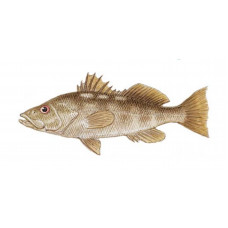Latin name
Paralabrax clathratus
Other names
Сalico bass, California kelp bass, rock bass, rock sea bass, sand bass, bull bass, kelp salmon, cabrilla; Spanish: cabrilla alguera.
Identification
A hardy fish with a characteristic elongated and compressed shape. It has a notch between the spines and dorsal fin. The longest spines in the first dorsal fin are longer than all the rays in the second dorsal fin. Coloration is brown to olive green, with pale spots on the back and lighter coloration on the belly. Kelp bass are easily distinguished from various sand bass by the third, fourth, and fifth dorsal spines, which are about the same length. Sand perch has a third dorsal thorn, much longer than the fourth and fifth dorsal spikes. Kelp bass are also similar in appearance to freshwater black sea bass, only their dorsal spines are longer and much heavier, and their overall appearance is rougher. , much longer than the fourth and fifth dorsal spikes. Kelp bass are also similar in appearance to freshwater black sea bass, only their dorsal spines are longer and much heavier, and their overall appearance is rougher. One of the many species of sea bass found in the eastern Pacific. The sea bass is one of the most popular sport fish in Southern California. It is an excellent food fish, highly prized by anglers. Its popularity and migrant-free status put the population at risk of overfishing.
Distribution
Bass is predominantly found along the central and southern coast of California, northeastern Baja, and from the Columbia River in Washington to Magdalena Bay.
Habitat
Larger fish stay in deeper water, up to about 150 feet, in kelp beds, over reefs, around jetties and breakwaters, and structures in shallow water.
Size
Kelp bass grows slowly, reaching a length of 12 inches in 5 to 6 years and becoming capable of spawning. Fish weighing 8 to 10 pounds can be 15 to 20 years old. The largest specimens weigh more than 15 pounds.
Life history and Behavior
They do not migrate and are usually territorial. Spawning takes place from May to September and reaches its peak in July.
Food and feeding habits
Kelp bass is omnivorous, prefers small fish, shrimp, crustaceans. Adults consume anchovies, small surfs and other small fish.
Reproduction
No information
| Classification | |
| Phylum | Chordata |
| Class | Actinopterygii |
| Family | Serranidae |
| Genus | Paralabrax |
| Species | P. clathratus |
| Features | |
| Conservation status | Least Concern |
| Habitat | Littoral |
| Life span, years | 34 |
| Maximum body weight, kg | 14 |
| Maximum length, cm | 75 |
| Sailing speed, m/s | 4 |
| Threat to people | Edible |
| Way of eating | Omnivore |
Bass, Kelp (Calico)
Tags: Bass, Kelp (Calico)

